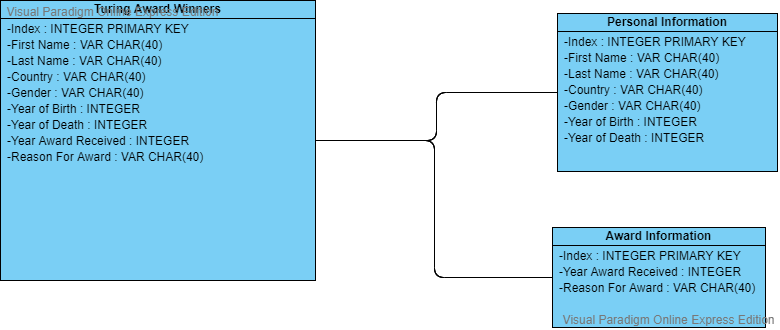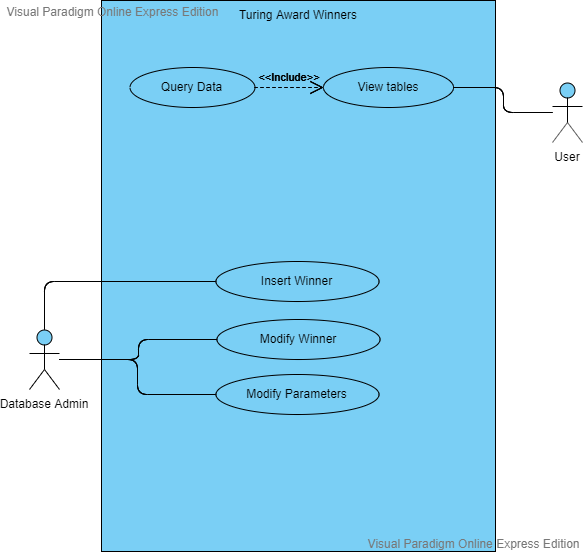A Use Case diagram is a method of describing all of the tasks and requirements a system must meet for various actors who would use/modify said system. An actor is essentially a person who is involved with the system, however they also could be an external application that is able to interact with said system. The use cases themselves are a list of minimum requirements a system must be able to fulfill in order to be considered complete. They also can be used to establish how an actor achieves their goal. There are five use cases total for the Turing Award Winner System, which are: View Table, Query Data, Insert Winner, Modify Winner and Modify Parameters. Two actors would be involved, which would be the Users and the Database Admins. Here is a list of each use case that would be available to a said actor and a basic description of what each use case would need to be able to perform.
Users
View Table
The users must be able to view all data on the Turing award winners, none of it should be hidden.
The data should be organised neatly into a table, allowing the users to easily comprehend said data.
Query Data
As an extension of viewing data, the users must be able to query the data using the MySQL programming language.
They should be able to reorganise the data, but not able to modify the base database in any way.
Database Admin
Insert Winner
Insert a new winner in the database so it can be seen by users.
Modify Winner
Modify an already existing winner to more accurately represent them.
Delete a winner from the list if their award is suddenly revoked.
Modify Parameters
Add or delete parameters that each winner needs in order to be complete.
Change already existing parameters to more useful ones.
As of right now, the database only keeps track of basic personal information, thus making its uses limited to simple things such as accessing how many award recipients are alive, how many received the award as a part of a group and how many are from the United States. In the future, useful parameters that could be added include: place of study, level of education, place of work, etc. These new parameters would create opportunities for more advanced queries such as: how many went to MIT? What award winners stayed at their school after graduation?
A UML Class Diagram is slightly different, in which it actually shows the contents of a system/database rather than an abstraction for use cases. A UML Class Diagram shows a systems’ operations, attributes and relationships between objects. Since this database is fairly simple, only attributes exist. Attributes, like in databases, essentially are variables for different rows of data provided. Attributes have data types that match database types, and the attribute names would be separated from these by a colon. Relationships between tables are also provided by the way classes are connected. In the UML Class Diagram for the turing award winners attached, only the inheritance relation is provided, of which two subclasses (Personal Information and Award Information) inherit data from the SuperClass (Turing Award Winners).
The UML Class Diagram and the Use Case Diagram are attached and should be visible below.
Use Cases explanation
https://online.visual-paradigm.com/diagrams/tutorials/use-case-diagram-tutorial/
UML Class Diagram explanation
https://www.visual-paradigm.com/guide/uml-unified-modeling-language/what-is-class-diagram/


